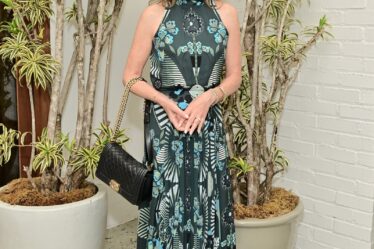In 1735, inspired by a passion for white gold, the Marquis Carlo Andrea Ginori opened a porcelain factory in Doccia, near the Italian manufacturing hub of Florence. Its porcelain products soon appeared in palazzos and courtyards, and the name “Ginori” became synonymous with Italian craftsmanship.
Over its near 300-year history, the Ginori brand has passed down generations. Over the years, it rebranded as “Richard Ginori”; it appointed renowned Italian architect and master Gio Ponti as creative director in 1923; and in 2016, it passed into the Kering group.
In the last three years, the brand has undergone its greatest evolution to date. In 2020, “Richard Ginori” rebranded to “Ginori 1735″, followed by the company’s transition from high-quality porcelain tableware to become a luxury lifestyle company. Recently, Ginori 1735 has collaborated with brands like Etro and creatives like artist and designer Luke Edward Hall and interior designer Luca Nichetto.
Amid the buzz in the Brera design district during Milan Design Week this April, Ginori 1735 unveiled its latest step forward for the heritage brand. On display in its recently redesigned Milanese flagship store in Piazza San Marco, the brand unveiled their broadening product offering into homeware, from venetian crystal and porcelain lamps to chairs and poufs wrapped in Oriente Italiano-designed print lifted from the collection.
Indeed, the opportunities in the luxury home furnishings and furniture market are on the rise, spurred on by the pandemic and people’s increased time spent in their homes. The market surpassed US$22.5 billion in 2022, according to Global Market Insights, and is expected to register a CAGR of 4.5 percent between 2022 and 2023.
Now, BoF sits down with Ginori 1735′s brand and product director Annalisa Tani to better understand the opportunities in homeware, its shifting consumer behaviour, and how the company is approaching the strategic rebranding of a near 300-year-old business.
How has Ginori 1735 approached its recent evolution?
The brand evolution is in keeping with our evolving concept of luxury, which we envision to be integrated more into everyday life. We want to link Ginori 1735 more to the rituals of our modern life, compared to the previous notion that luxury products were more distant and only for special occasions.
The DNA of Ginori 1735 started from our heritage but embodies where we want to go. We call it: “Gracious Audacious”. “Gracious” is linked more to the past — the luxury, the sophistication, the Tuscan, the elegance — and the “audacious” is the way the brand is exploring the unexpected, and its capacity to look forward. We integrate this approach in everything we do, from our communication strategy to the product design, and it has driven the brand forward in the last few years.
It was first about how products transform the table, but it’s not just the product — it’s about the way you approach the product. I don’t believe in creating a total lifestyle look, as everyone is different. We do not want to impose our style on everyone but to allow them to share in its attitude. So, every piece is designed to be a statement and could go in any home, so we have basic, minimal styles as well as more bold styles.
How are you approaching your product design and category expansion?
We are expanding our categories to tell more stories about the Ginori 1735 heritage. Outside of tableware, it felt natural to expand to products that frame the way we want our tableware and objects to be presented. So, with the new Domus collection, we are expanding with a collection of lamps, furnishings and fabrics, marking the company’s debut into interior design.
There are no competitors that use the same materials that we use together in the Domus collection — the lamp, for example, uses venetian crystal and Ginori 1735 porcelain in a completely new way.
We created the Domus collection with two other prestigious Italian brands: Barovier&Toso and Rubelli. We believe they have the same DNA as Ginori 1735, and it is quite a unique partnership in Italy — to have three heritage brands giving life to a collection. We are approaching it with our heritage focus and emphasising the savoir faire.
How does the new store design reflect the brand’s plans for the future?
This is the store we imagine for the future — it is about combining timeless elegance with functionality and modernity, so an eclecticism that connects to our heritage.
Attention to detail in the store redesign is crucial as it highlights the craftsmanship and new materials used in Ginori 1735 products.
For this, the store must have maximum flexibility and more room, so it can be adapted to host different collections and categories. But this approach also means that we can host small events, like dinners or art exhibitions. The previous version of the store was too closed and, as a result, more difficult to manage.
Attention to detail in the store redesign is also crucial as it highlights the craftsmanship quality and new materials used in Ginori 1735 products. This connects back to our heritage and the Manifattura. We have then linked the Milan flagship store design to the Milano aesthetic, combined with our signature style, like the gold detailing and use of Ginori blue.
What shift in consumer behaviour is Ginori 1735 responding to today?
Social media and the pandemic prompted consumers to focus more on lifestyle experiences — and fashion brands are moving into interiors to cater to that demand.
The younger generation has a stronger drive to slow down, and real luxury for us is connected to this notion of slowing down. Luxury is taking the time for ourselves and concentrating on the lives that we lead.
This change in attitude speaks to how we produce things at Ginori 1735 — our production takes time by its very nature —we cannot do things quickly. The Domus collection took almost three years to make because we want to use the same skills and approach that we have for porcelain.
What is your next focus for Ginori 1735?
After Salone del Mobile, we will be launching a campaign with Jake Gyllenhaal. We typically select Ginori 1735 collaborators from different fields — from art, design, even photography. But this is the first time a brand like Ginori 1735 is doing something this out-of-the-box, as the use of talent and actors was really more linked to fashion campaigns.
We choose collaborators based on their creative approach that is aligned with the Ginori 1735 vision and brand identity. It gives another perspective and allows us to more clearly express what we want to say in that moment. They are able to interpret and convey the Ginori 1735 heritage and craftsmanship with an innovative spirit in their work and with their style.
For the campaign, Jake spent some time in our Manifattura as we wanted to keep our roots strong. We didn’t just want a face for the campaign, but someone who can spread our culture and our attitude to the wider world. It’s really an experience that we create with him there.
This is a sponsored feature paid for by Ginori 1735 as part of a BoF partnership.



